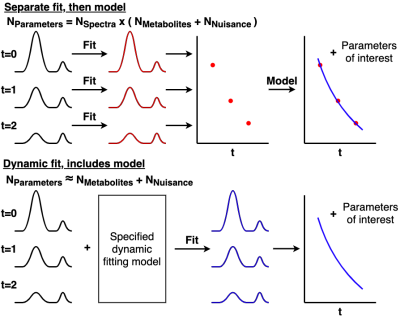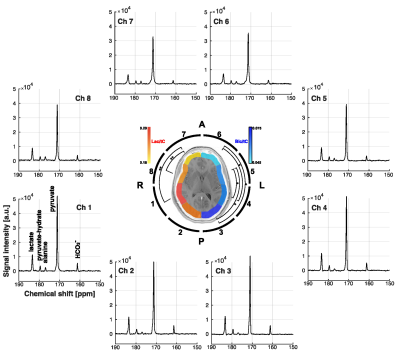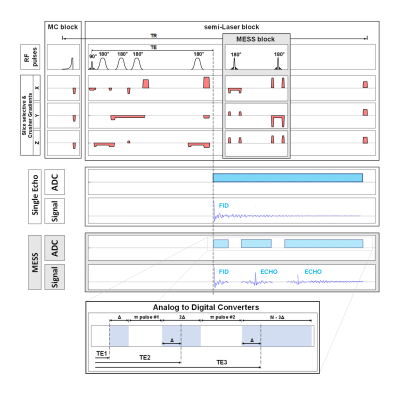Oral Session
MR Spectroscopy (fMRS, dMRS
Joint Annual Meeting ISMRM-ESMRMB & ISMRT 31st Annual Meeting • 07-12 May 2022 • London, UK

| 14:30 | 0307 |
Changes in occipital GABA, glutamate/glutamine concentrations and cerebral oxygen metabolism in response to visual stimulation
Kimberly L Chan1, Hanzhang Lu2, Zixuan Lin2, Anke Henning3,4, and Binu P Thomas1
1Advanced Imaging Research Center, The University of Texas Southwestern, Dallas, TX, United States, 2Johns Hopkins University, Baltimore, MD, United States, 3The University of Texas Southwestern, Dallas, TX, United States, 4Max Planck Institute for Biological Cybernetics, Tübingen, Germany
The relationship between brain’s GABA and glutamate/glutamine (Glx) concentrations measured by 1H MRS, hemodynamic response, neural signaling, and behavior is poorly understood. Here, the relationship between MRS-detectable GABA and Glx signals and MR hemodynamic contrasts during visual stimulation were examined. It was observed that changes in GABA+ and Glx were positively correlated with the BOLD response and negatively correlated with their levels at rest. Additionally, task GABA+ concentrations were negatively correlated with cerebral metabolic rate of oxygen (CMRO2). Together, these results suggest shifts in the inhibitory/excitatory balance and metabolism to maintain homeostasis in the brain.
|
|
| 14:42 | 0308 |
Robust diffusion-weighted spectroscopic imaging throughout the mouse brain
Eloïse MOUGEL1 and Julien Valette1
1Université Paris-Saclay, Commissariat à l’Energie Atomique et aux Energies Alternatives (CEA), Centre National de la Recherche Scientifique (CNRS), Molecular Imaging Research Center (MIRCen), Laboratoire des Maladies Neurodégénératives, Fontenay aux Roses, France
Being more specific to cellular microstructure than water diffusion, diffusion-weighted spectroscopic imaging (DW-MRSI) is a powerful tool for measuring disorders in cortical gray matter. Nevertheless, measurement in the cortex is difficult due to its proximity to the skull. We propose a selective DW-MRSI sequence, which avoids lipid contamination and measures the signal of metabolites even in the cortex. We performed an in vivo acquisition with this sequence and were able to measure an apparent diffusion coefficient over an entire brain slab.
|
|
| 14:54 | 0309 |
Dynamic fitting of functional MRS, diffusion weighted MRS, and edited MRS using a single interface
William T Clarke1, Clémence Ligneul1, Michiel Cottaar1, and Saad Jbabdi1
1Wellcome Centre for Integrative Neuroimaging, FMRIB, Nuffield Department of Clinical Neurosciences, University of Oxford, Oxford, United Kingdom Dynamic magnetic resonance spectroscopy acquires multiple spectra under changing experimental conditions. Examples include editing, functional MRS, and diffusion weighted MRS. In this work we introduce a new tool that allows direct fitting of a dynamic signal model to multiple spectra simultaneously. Incorporation of a dynamic model into multi-spectra fitting reduces the number of parameters to be estimated from noisy data, reducing overall uncertainty.
The tool is demonstrated on simulated and multi-subject in vivo datasets, highlighting the high flexibility of the tool, which is open source and available as part of the FSL-MRS toolbox. |
|
| 15:06 | 0310 |
Dynamic 13C MRS using 13C/1H Multichannel Coil as an Alternative to Imaging for Hyperpolarized Pyruvate Brain Studies
Junjie Ma1, Marco C. Pinho1,2, Crystal E. Harrison1, Jun Chen1, Galen D. Reed3, Albert P. Chen3, A. Dean Sherry1,4, Craig R. Malloy1,2,5, Christopher J. Madden6, and Jae Mo Park1,2,7
1Advanced Imaging Research Center, UT Southwestern Medical Center, Dallas, TX, United States, 2Radiology, UT Southwestern Medical Center, Dallas, TX, United States, 3GE Healthcare, Dallas, TX, United States, 4Biochemistry and Chemical Biology, UT Dallas, Richardson, TX, United States, 5Internal Medicine, UT Southwestern Medical Center, Dallas, TX, United States, 6Neurological Surgery, UT Southwestern Medical Center, Dallas, TX, United States, 7Electrical and Computer Engineering, UT Dallas, Richardson, TX, United States
This study demonstrates that time-resolved 13C MR spectroscopy with the multichannel 13C/1H RF coils can be performed as an alternative to imaging for assessing pyruvate metabolism using hyperpolarized [1-13C]pyruvate in the human brain.
|
|
| 15:18 | 0311 |
Multi-Parametric Single-Shot Magnetic Resonance Spectroscopy for Fast Metabolite-Specific Concentration and T2 Determination
Rudy Rizzo1,2 and Roland Kreis1,2
1Magnetic Resonance Methodology, Institute of Diagnostic and Interventional Neuroradiology, University of Bern, Bern, Switzerland, 2Translational Imaging Center, sitem-insel, Bern, Switzerland
Multi-Echo Single-Shot (MESS) spectroscopy is tested in-vivo aiming at simultaneous determination of metabolite content and T2 times through simultaneous multi-parametric model fitting of partially sampled echoes. Cramer-Rao Lower Bounds (CRLBs) are used as measure of performances. The novel scheme was compared with the traditional Multi-Echo Multi-Shot (MEMS) method. Results confirmed former in-silico studies and indicate that MESS outperforms MEMS for simultaneous determinations of T2s and concentrations, with improvements ranging from 5-20% for T2s and 10-50% for concentrations.
|
|
| 15:42 | 0312 |
Assessing potential correlation between T2 relaxation and diffusion of brain lactate Video Permission Withheld
Eloïse MOUGEL1, Sophie Malaquin1, and Julien Valette1
1Université Paris-Saclay, CEA, CNRS, MIRCen, Laboratoire des Maladies Neurodégénératives, Fontenay aux Roses, France
Little or no correlation exists between diffusion and T2 relaxation of intracellular brain metabolites, as measured by MRS. However, for lactate, which is both intracellular and extracellular, some correlation might exist, which would be crucial to interpret lactate diffusion. Using a frequency-selective diffusion-weighted (DW) MRS sequence that removes J-modulation on the lactate peak at 1.3 ppm, thus preserving lactate signal even at long TE, we investigated the effect of echo time TE on lactate diffusion-weighted attenuation, for TE between 50.9 and 110.9 ms. It appears that the effect of TE on the apparent diffusivity and kurtosis is negligible.
|
The International Society for Magnetic Resonance in Medicine is accredited by the Accreditation Council for Continuing Medical Education to provide continuing medical education for physicians.